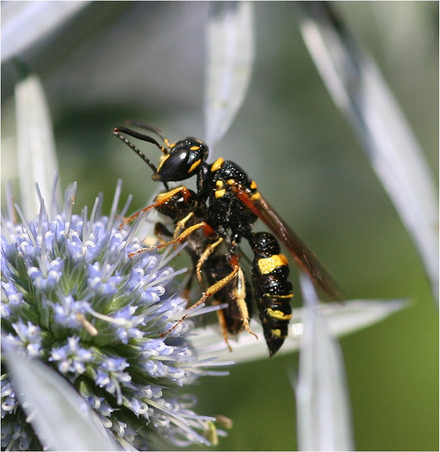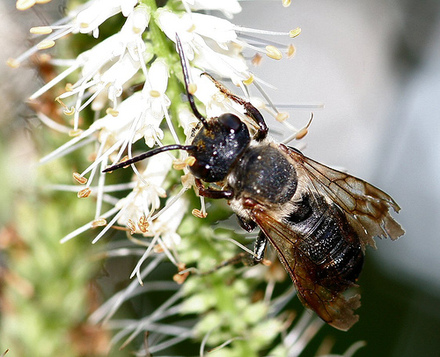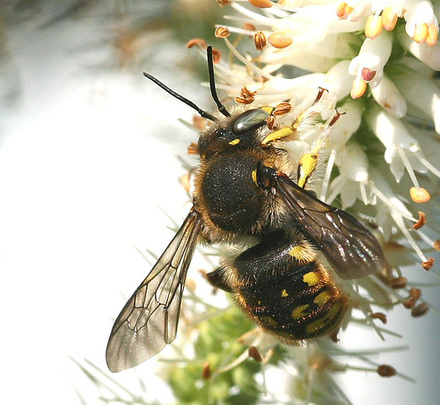In August, I described my summer “project,” to learn more about the flies, bees, and wasps in my yard. I posted a series of some of the photos I took of the cool Diptera (flies) I was able to identify. You foolishly encouraged me to do more posts in this vein, so here I am, with some of the Hymenoptera (the order containing bees, wasps, and ants) I’ve found in the yard.

Above is a grass-carrying wasp, Isodontia elegans. Grass-carrying wasps are solitary wasps which provision their larvae with tree crickets (typically). They make their nests in hollow objects. Females snip blades of grass and line a nest cell with them. I’ve seen the all-black native species, I. mexicana, entering the hollow window bars of our campus parking structure, trailing grass behind them. They’ll also nest in the furrows of window frames; homeowners may find the nests when installing storm windows in the fall.
This photo is the first taken in Michigan of I. elegans, an introduced species. The following year my entomologist friend Mark (also apt to find new records on his property) vouchered the first specimen, and we co-authored a paper. These wasps are as common as mexicana in my yard. It just shows you that you never know what you might find right under your nose if you look.

This small solitary wasp is Philanthus gibbosus, one of the species commonly known as “beewolves.” As the name suggests, they are predatory, and prey on bees. They are quite abundant, but this is the only time I’ve ever seen one grab a bee. Lucky shot.

Two very large wasps in the genus Sphex are common at flowers in summer. One is the blue-black S. pensylvanicus. The other is this species, the Great Golden Digger Wasp, Sphex ichneumoneus . Digger wasps dig burrows for their nests, and provision them with crickets, grasshoppers, and katydids. Although imposing, they are not aggressive. I’ve never been stung no matter how close I’ve gotten for a photo.

Only a week after the first Giant Resin Bee (Megachile sculptularis) was discovered in northern Michigan (by my friend Mark’s wife!), I colllected one at one of my study sites about 30 miles from my house. That same day, I came home and found this one in my yard. This species was introduced into the U.S. from Asia, with the first one being recorded from North Carolina in 1994. More info here. Another paper to co-author. I publish more stuff about insects than birds!

While we’re on the topic of introduced species, here are a couple of interesting ones. Wool carder bees are leaf cutting bees. Most leaf cutting bees cut semi-circular holes out of leaf margins and use the pieces to line their nests, which are in burrows or cavities. Wool carder bees use the “wool” from felted plants (like lamb’s ears). The species above, Anthidium manicatum, is introduced from Europe, purposely brought here as a pollinator. Another species, A. oblongatum (below, in a photo I took at work), was introduced in 1995…I’m not sure if that introduction was intentional.


Finally, we’ll wrap it up with one of the several species of bumblebee I’ve found in the yard, the Golden Northern Bumblebee, Bombus fervidus. They are particularly soft and plush looking, and very fond of the zinnias!
I got to 42 species photographed and identified in the yard so far, and another 20 species nearby. I’ve a few photos I’m still working on. The asters are still in bloom in the extended summer weather, so I might find a few more before frost. This was a really gratifying project that I’ll continue next year. Now that I have learned to recognize many Diptera and Hymenoptera to family, I will probably be trying to photograph and ID some tropical species as well. My next opportunity will be January in Panama. Expect a tropical insect photo salon this winter!

Comments on this entry are closed.
Nuthatch, these photos are awesome and the info was extremely interesting. I didn't realize we had so many introduced bees and wasps. What source have you been using to ID them? I assume it helps having an entomologist buddy.
Yes, especially one who did all his dissertation work on wasps! I rely heavily, but not exclusively on two great resources to identify insects. First, is BugGuide.net. It often at least gets me in the neighborhood, and then I verify with other online resources, as well as the very engaging and beautiful book, Insects: Their Natural History and Diversity. I can't recommend it enough. I was also surprised at the number of introduced bees and wasps (and flies). I'm sure there are even more out there than we think.
Here is an example of leaf-cutting bee work.
Indeed, this was most informative. I've been wondering for the last two years what "bug" has been eating so neatly the edges of my morning glory leaves. Now I can say it is a leaf-cutting bee. I've never seen them on the plants, but always seem to find the evidence afterwards. Thanks.
Your last paragraph says that you "…will probably be trying to photograph and ID…"
Perhaps you "…will probably bee trying…"
Ugh.
ooh! What great photos!!!
A very nice post–thanks for the info :)
I've put a link to this post up at Linnaeus' Legacy.
Thanks, Chris. Readers, check out this cool series started at Chris's blog, Catalogue of Organisms. Eh, nearly wrote "orgasms."
For sale by owner (FSBO) houses can be found in New Jersey by making use of the FSBO listings available online. You can also choose from a range of FSBO properties namely FSBO lands, farms, ranches etc. The FSBO real estate listings in New Jersey can also be procured from the mortgage companies and local county offices and you can make use of them to buy some excellent properties. You can contact the owner directly for the completion of deal or get the help of FSBO realtors for the same.
for more information to go this link
——————————————–
mikeadam
Homes For Sale